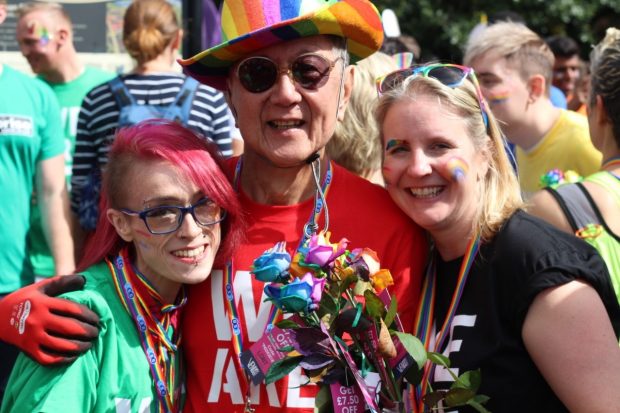
Where evidence is available, it suggests that cancer screening coverage is lower in lesbian, gay, bisexual, and transgender (LGBT) communities.
Not attending screening ties into wider findings in terms of LGBT people and their reluctance to access healthcare.
For example, a Stonewall report found that 14% of LGBT people, including 37% of trans people, have avoided accessing healthcare services due to fear of being discriminated against.
Furthermore, the National LGBT Survey found that:
- at least 16% of respondents who had accessed or tried to access public health services have had a negative experience based on their sexual orientation
- 38% have had a negative experience related to their trans status
The LGBT survey pointed out that more research was needed to determine the effect these factors were having on health.
Cervical screening
Lesbian and bisexual (LB) women are less likely to have been for cervical screening. Figures show that 15% of LB women over 25 have never had a cervical screening test compared to 7% of women over 25 in general.
This lower uptake is partly due to the misconception that women who only have sex with women do not require cervical screening tests.
Told ‘not at risk’
One LB women’s health check found that 20% of LB women who had not attended a cervical screening did not think they were at risk of cervical cancer.
Possible reasons for this are highlighted by an LGBT Foundation study in the North West which found that 37% of LB women were told at one point that they did not need a test because of their sexual orientation, in some instances by healthcare professionals.
The study found 14% had been actively refused or discouraged from having a cervical screening by a healthcare professional as a result of their sexual orientation.
One respondent quoted in the North West study said:
Nurses and doctors have always said I don’t need screening, that lesbians cannot get cervical cancer.
Half of LB women who hadn’t had a cervical screen test said they were ‘scared’ to have the test.
One factor which could be contributing to coverage being lower may be that people who don’t have penetrative sex may find the procedure more uncomfortable and invasive. To reduce this discomfort, LB people may need a smaller speculum, however they may be reluctant to discuss this. In 2017, 53% of LB women did not disclose their sexual orientation to healthcare staff.
Trans men who still have a cervix should consider screening. There is limited evidence on coverage among trans men. However, a small scale US study found half of trans men had not had a test in the previous 3 years.
Breast screening
The evidence is more limited in terms of breast screening coverage among LB women.
A Stonewall survey found that 80% of lesbians over the age of 50 have had a breast screening test, which is roughly the same to women in general. However, among women over 40, 80% of heterosexual women would go to the doctor within a week of finding a lump, compared to 75% of lesbians and 68% of bisexual women.
There is a perception that healthcare professionals do not have adequate knowledge surrounding screening and LB women.
37% of lesbians, compared to 69% of heterosexual women, thought that appropriate attitudes of healthcare professionals contributed to a good experience of breast screening.
Trans men and women often should consider breast cancer screening, but there is no evidence on coverage of breast screening among trans people.
Bowel cancer screening
There is no evidence on LGBT people’s uptake of bowel cancer screening.
More evidence needed
As you can see, evidence on cancer screening coverage in LGBT communities varies and this is something that urgently needs to be addressed.
The 2018 National LGBT Action Plan highlighted the need to put LGBT people’s needs ‘at the heart of the National Health Service’, however not knowing enough about what these needs are creates a barrier to progress.
Implementing sexual orientation and trans status monitoring across all NHS services would ensure there is up-to-date and comprehensive evidence on LGBT communities’ experiences of healthcare, including cancer screening coverage. More information about monitoring is available online via the LGBT Foundation.
Advice for local screening services
Simple steps such as having LGBT posters or leaflets in waiting rooms and having staff wear rainbow lanyards or badges can go a long way in making LGBT people feel more welcomed and included at screening services. Staff shouldn't make assumptions about whether a person is LGBT or not if they haven't said.
More blog posts to come
This post is the first in a series about cancer screening in LGBT communities. Next up, we'll be looking at cancer screening in trans communities and how screening services can take steps to be more LGBT inclusive. Further information on cancer screening for trans people can be found in PHE’s guide to NHS Screening Programmes for trans people.
In May 2018, PHE Screening’s inequalities strategy was launched to highlight our commitment to reduce inequalities in access to screening services and address barriers that prevent people and communities from engaging with or participating in screening.
PHE Screening blogs
PHE Screening blogs provide up to date news from all NHS screening programmes. You can register to receive updates direct to your inbox, so there’s no need to keep checking for new blogs. If you have any questions about this blog article, or about population screening in England, please contact the PHE screening helpdesk.